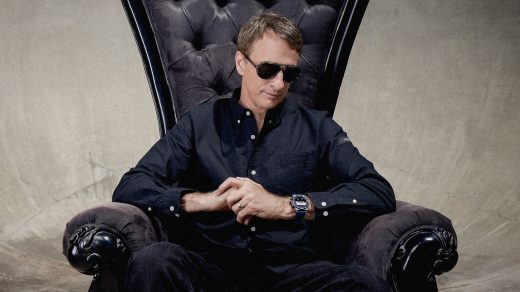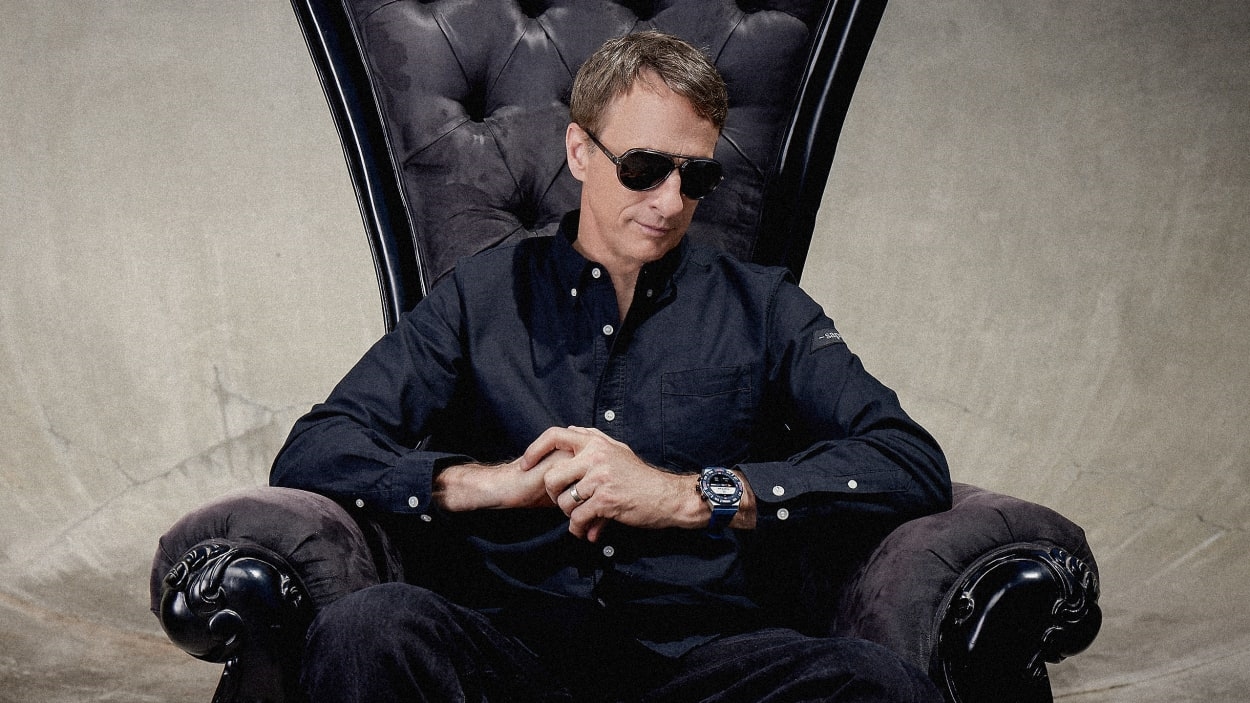Tony Hawk is right on time as the new face of Citizen smartwatches
For a 54-year-old extreme sports star, time is of the essence. There must be enough time left within the biological aging process for a mass of mitochondria to push the body to terrifying extremes, twisting and twirling high above ground, dazzling onlookers with the total banishment of fear in motion. Enough time midair to bring that body around to a graceful landing, one that can defy death many times over. Enough time away from the demands of adult life to train, so those landings stick more often than not. Enough time measured in years, down to milliseconds.
That might be why skateboarder Tony Hawk—one of the few athletic legends whose name is synonymous with his sport—is a watch buff. Speaking via Google Meet from his home in San Diego, where he sits at a large wooden desk packed with colorful books and figurines—along with what looks like a penny board, or at least a miniature skateboard replica on display—Hawk delves into this watch addiction, geeking out for a minute.
“As a kid, I remember when calculator watches came out, and that seemed like the most cutting-edge thing you could possibly get,” he says. “A calculator on your wrist! So, that’s what I wanted for Christmas. As I got older, my tastes got a little more refined. And I indulged a couple times . . . I have close to 30 now.”
Decades later, he’s parlayed that interest into a partnership, announced on Monday, with Citizen, a watch brand whose wrist pieces are typically priced between $200 and $5,000. As part of the deal, Hawk will be the face of Citizen’s second-generation CZ Smart watch, which was paraded out in Las Vegas at CES in January and is powered by research from NASA and artificial intelligence built with IBM Watson.
It’s “a piece of NASA on your wrist,” the company touts.
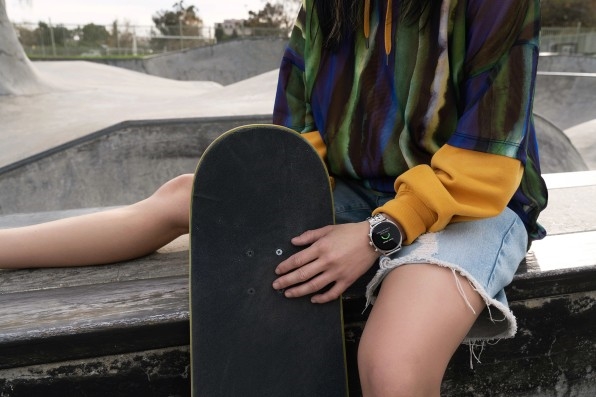
Skate hard, skate smart
According to Citizen, the smartwatch’s hero wellness app, YouQ, is ultra biologically tuned, categorizing wearers into different “chronotypes”—genetic markers of a person’s natural sleep rhythm, like when they prefer to doze or wake—and uses those to predict their physical and mental energy throughout the day, rising to peaks and falling to valleys (the low of a 2 p.m. post-lunch food coma, or the high of a 6 p.m. post-cardio euphoria). It then recommends a slew of “power fixes,” such as ingesting more protein or partaking in a quick acupressure session.
For a watch nerd, Hawk (whose chronotype is “Mid-Day Dynamo”) was uncharacteristically slow to catch the smart-tech bandwagon. “I’ve never worn anything that tracked my health before,” he says. His first was a Citizen, which he now wears when he skates, checking his heart rate, calories burnt, and sleeping schedule, or, occasionally, using a feature that tests his reflexes on the spot.
“I think the watch thinks I’m doing aerobics,” he jokes.
To be sure, he’s pretty aerobic. Hawk, nicknamed “the Birdman,” spent the 1980s blazing a red-hot trail in skateboarding, setting record after record as he took the sport—once dismissed as a wanton thrill for misfits and delinquents—to dizzying heights (literally). He pioneered so-called “vertical skateboarding”—which involves launching oneself up a sort of half-pipe, then spinning and flipping as much as possible—and coined a word-salad of tricks, such as the “ollie-to-indy,” the “gymnast plant,” the “Saran wrap,” and the “frontside 540 rodeo flip.” In 1999, he landed the first-ever 900—two-and-a-half full revolutions in air, turning a total of 900 degrees—at the X Games, after 10 failed attempts. Nowadays, he skates with the weight of history on his shoulders.
But as it gets heavier, the body must bend to time. Hawk is gearing up for yet another X Games this May in Chiba, Japan, just outside of Tokyo—a deferred performance from last year, when he was set to skate the “vert best trick” contest but then broke his femur a few weeks before the games, in what he’s called the worst injury of his life.
“As I get older, I’m getting more aware of what I need to be able to keep doing this—a healthier diet, a better schedule,” he says. “When I got hurt, I was in denial of how long I was going to take to heal. I went into it much too quickly, and ended up sabotaging my first recovery. So, as I got the second chance, I realized that I’m lucky to live in this age of technology and modern medicine.”
Cue . . . the CZ smartwatch. When he drops in to the vert ramp next month, maybe the piece of NASA on his wrist can help him fly.
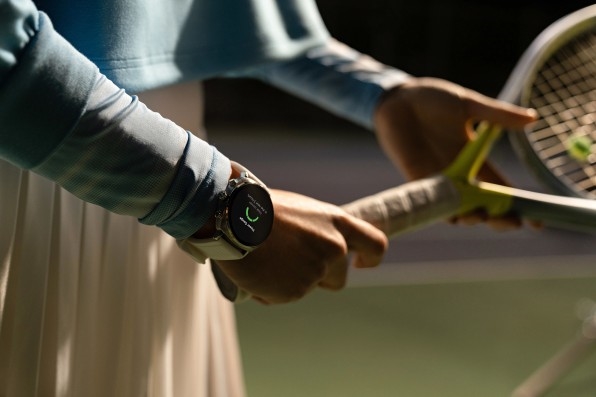
For the love of the games
Of course, Hawk still competing is an extreme anomaly. Like many action stars, he retired in his 30s—hanging up his skateboard in 2003. He raised four children, including one professional skateboarder and one electronic music producer. Then came the “fluke,” as he calls it. Almost two decades later, in 2021, the X Games happened to take place near his home, and he happened to drift over there, and he saw that the tricks those skaters were throwing down on the course were not that far off from what he was throwing down in his own backyard.
Within an hour, he was in the arena, crowd roaring. “Hey! I’m still good at it,” he thought. “Why not jump in?” He ended up losing to a 12-year-old from Brazil, the youngest gold medalist in the history of the games.
But this year, he says, it’s not about winning trophies. “I don’t have some great aspiration for career goals,” he says. “It’s a celebration of how far I’ve come and how long I’ve been doing this. What other sports event are you going to see people in their mid-50s competing with people who are teenagers, on equal footing?”
It’s true—that’s rare. And as time marches on, Hawk can’t deny that skateboarding’s old guard will make way for new blood. Today, there are kids from Japan who are 10 years old—and younger—landing 1080s, he notes. “There are tricks that kids learn their first year of skating that weren’t even invented until I was in my late teens,” he says. “It’s been very challenging, overcoming this traumatic injury, and then being faced with, ‘Can you still create new tricks?’ I’m trying.”
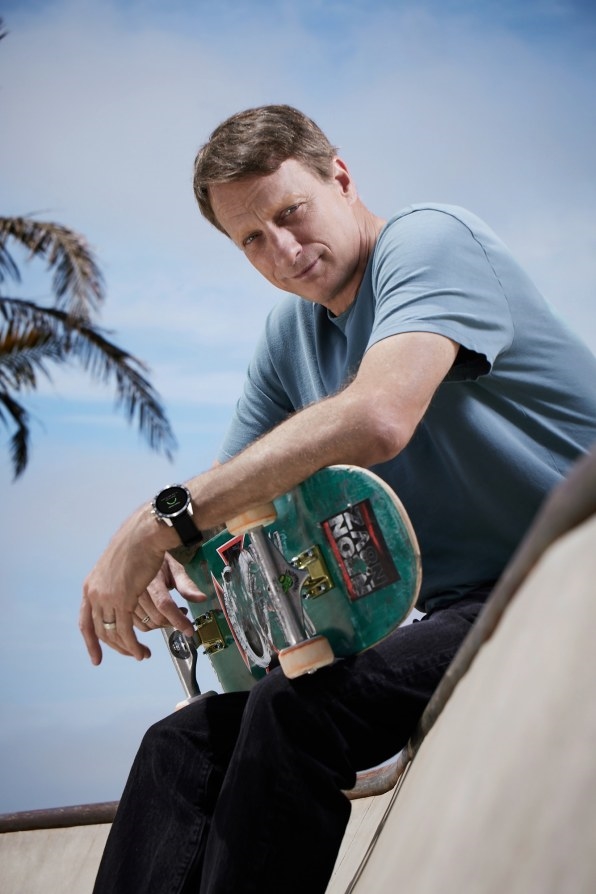
New country for old men
But many skaters will tell you that Hawk’s pivotal, first-ever 900 is the reason why kids can reach for 1080s today. He’s been pushing the boundaries of his sport for so long. He also knows that one day, he will leave the arena and never step back in. How will he know when it’s time?
“I guess if I feel like my skills are truly fading, and I’m not worthy of the title of professional skateboarder, then I won’t be doing it in public,” he muses. “But I will probably continue to skate” . . . with the help of his CZ smartwatch.
It’s not the only thing he uses it for. “I like measuring my steps that I take through airports,” Hawk says. “I measure the distance between terminals, because I travel a lot.” In fact, he’s just returned from a trip to the Navajo Nation, where his foundation, The Skatepark Project, constructed a “skate garden,” complete with rails, a bowl, and a rainbow-shaped ramp, serving the Dine community in New Mexico.
It’s a cause that’s close to his heart. “I would like to see more countries supporting skating in the form of skateparks,” he says. “That’s my passion. That’s what I do with my philanthropy.”
His dream for skateboarding is that—just like the CZ smartwatch—the next generation will be better than the last. Skateboarding has already strode far—up hills, down alleys, across oceans. In the 1960s, it was a band of renegades who took to surfing the streets of southern California barefoot, making empty swimming pools their playground. In 2020, it debuted as an Olympic event, and it’s something kids choose to do “as readily as they choose any mainstream stick-and-ball sport,” Hawk says.
The road is being paved for these young skateboarders to speed toward a brighter future. Like Hawk’s, their time will come, too.
(6)

